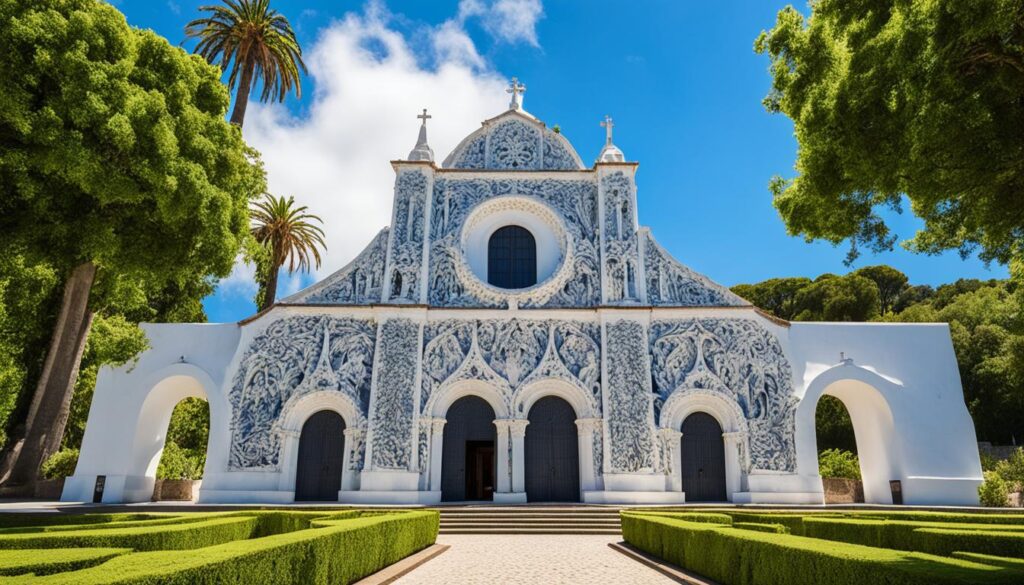Welcome to the University of Coimbra, one of the oldest and most prestigious universities in Europe. Located in the beautiful city of Coimbra, Portugal, this top-rated institution is steeped in rich history and boasts impressive architectural landmarks. Whether you’re a history enthusiast, a book lover, or simply looking for a remarkable cultural experience, the University of Coimbra is a must-visit destination.
Established in 1290, the University of Coimbra holds the distinction of being one of the oldest universities in Europe and is recognized as a World Heritage Site by UNESCO. Its current building, constructed in 1544, showcases stunning Renaissance architecture that will transport you back in time. Intricate details and intricate designs adorn the university’s historic buildings, creating a captivating atmosphere that is truly unique.
Table of Contents
ToggleKey Takeaways:
- The University of Coimbra is one of the oldest universities in Europe and a World Heritage Site.
- The university’s historic building dates back to 1544 and showcases beautiful Renaissance architecture.
- Coimbra University’s library is one of the world’s finest, with a collection of 40,000 books.
- Explore the university’s historic buildings, including the Chapel of São Miguel and the Graduates’ Hall.
- Visit the Natural History Museum and Science Museum to delve into fascinating collections and interactive displays.
The Magnificent Library of Coimbra University
The library of Coimbra University is considered one of the world’s finest. It was a gift from King João V and contains 40,000 books. The library is accessed through the Academic Prison, which was in use from 1773 to 1834. To protect the books from insects, the library houses two colonies of bats that come out at night. The library’s collection is covered in gold leaf, and it is one of the highlights of a visit to the university.
“The library of Coimbra University is a true masterpiece, both in terms of its architecture and its collection of books. It is a testament to the grandeur of King João V’s vision for education.”
The library’s connection to the Academic Prison adds an intriguing element to its history. The Academic Prison served as a place of confinement for students who violated university regulations. Today, it serves as an entrance to the library, creating a unique and memorable experience for visitors.
The decision to house bats within the library may seem unusual, but it serves an important purpose. Bats are natural predators of insects, and their presence helps protect the precious books from damage. While visitors may not see the bats during the day, knowing they are there adds to the library’s allure and mystique.
Stepping into the library is like stepping into a treasure trove of knowledge and beauty. The collection, adorned with gold leaf and meticulously curated, showcases the rich history and intellectual heritage of Coimbra University. From ancient manuscripts to rare volumes, each book tells a story and invites exploration.
Visiting the library of Coimbra University is an experience that immerses you in the world of academia and showcases the commitment to education and knowledge that has defined the university for centuries.
Exploring the University's Historic Buildings
The University of Coimbra’s historic buildings showcase a captivating blend of architectural styles. From religious sanctuaries to regal chambers and towering structures, these landmarks offer a glimpse into the rich history of Coimbra. Immerse yourself in the beauty and grandeur of the Chapel of São Miguel, the Graduates’ Hall, and the iconic Clock Tower. As you navigate the campus, don’t miss the cobblestone pavement that leads you to the entrance gate, adorned with depictions of the revered Roman goddess Minerva.
The Chapel of São Miguel
Nestled within the university grounds, the Chapel of São Miguel is a true testament to opulence. Step inside this ornate chapel to marvel at its brightly-painted ceiling, adorned with intricate designs and vibrant colors. The chapel is also home to a remarkable pipe organ dating back to 1733, adding to its mesmerizing aura. Discover the breathtaking beauty and spiritual significance of this architectural gem.
The Graduates' Hall
Formerly the Throne Room, the Graduates’ Hall exudes a regal charm. Adorned with magnificent 17th-century portraits of Portuguese kings, this hall is steeped in historical significance. As you walk through its grand doors, you’ll be transported back in time, surrounded by the stories of past graduates who once gathered there to celebrate their academic achievements. Immerse yourself in the ambiance of this remarkable space.
The Iconic Clock Tower
Rising above the university campus, the Clock Tower stands tall as a symbol of Coimbra. Climb the tower to enjoy a breathtaking panoramic view of the city below. As the clock chimes, time seems to stand still, allowing you to appreciate the beauty of Coimbra from a unique perspective. Capture unforgettable memories and immerse yourself in the enchantment of this iconic landmark.
The Cobblestone Pavement
Before venturing into the historic part of the university, take a moment to admire the cobblestone pavement that leads to the entrance gate. As you walk along this picturesque path, you’ll encounter an exquisite depiction of the Roman goddess Minerva. Each cobblestone intricately showcases the goddess, bringing an artistic touch to the journey. Let the charm of this pavement guide your way as you embark on your exploration of the university’s majestic buildings.

| Historic Building | Description |
|---|---|
| Chapel of São Miguel | An ornate chapel with a brightly-painted ceiling and a pipe organ from 1733. |
| Graduates’ Hall | Once the Throne Room, it is decorated with 17th-century portraits of Portuguese kings. |
| Clock Tower | An iconic landmark offering a panoramic view of Coimbra. |
| Cobblestone Pavement | A picturesque path leading to the entrance gate, adorned with depictions of the Roman goddess Minerva. |
Museums at Coimbra University
Coimbra University boasts two prestigious museums that offer a unique glimpse into the world of natural history and scientific exploration. These museums provide fascinating insights into the university’s rare collection of specimens and scientific instruments.
Natural History Museum
The Natural History Museum at Coimbra University is a treasure trove of fossils, minerals, and animal skeletons. Housing a remarkable assortment of specimens, the museum showcases the rich diversity of life on Earth. One of its noteworthy highlights is a massive whale skeleton that dominates an entire room, leaving visitors in awe of its sheer size and majesty. These extraordinary exhibits have been collected during groundbreaking expeditions spanning the Portuguese Empire, making the collection particularly valuable and historically significant.
Science Museum
The Science Museum, located in the university’s former science laboratory, takes visitors on an interactive journey through various scientific disciplines. Through captivating displays and hands-on exhibits, the museum aims to promote science education and inspire curiosity in visitors of all ages. The museum’s engaging exhibits cover a wide range of topics, including physics, biology, chemistry, and astronomy. Visitors can delve into the world of scientific discovery and exploration, immersing themselves in the fascinating world of scientific instruments and cutting-edge research.
These museums at Coimbra University offer an extraordinary opportunity for both locals and tourists to delve into the wonders of natural history and scientific exploration. Whether you’re captivated by the rare collection of fossils and animal skeletons at the Natural History Museum or fascinated by the interactive displays and scientific instruments at the Science Museum, a visit to these museums promises an unforgettable educational experience.
| Benefits of Visiting the Museums | Visitor Experience |
|---|---|
| Opportunity to explore the university’s rare collection and scientific instruments | Engaging interactive displays promote hands-on learning |
| Learn about different scientific disciplines and their significance | Immerse yourself in the wonders of natural history and scientific discovery |
| Discover the historical importance of the specimens and expeditions | Gain a deeper understanding of scientific advancements throughout history |
Conclusion
Visiting Coimbra University is an unforgettable experience that allows you to immerse yourself in the rich history and architectural beauty of one of the oldest universities in Europe. While access to the library may be limited, there are still plenty of opportunities to explore the university’s historic buildings, museums, and marvel at the stunning architecture.
To make the most of your visit, it’s recommended to purchase admission tickets from the ticket office and arrive early to secure a convenient time to visit the library. This will ensure that you have ample time to fully appreciate the unique treasures within its walls.
Additionally, don’t miss out on exploring other nearby attractions during your visit to Coimbra. The Machado de Castro National Museum and the New Cathedral are just a stone’s throw away and offer further insights into the city’s rich cultural heritage.
FAQ
What is the University of Coimbra?
The University of Coimbra, also known as Coimbra University, is one of the oldest universities in Europe and is located in Coimbra, Portugal. It was founded in 1290 and is recognized as a World Heritage Site.
What is special about the library at Coimbra University?
The library at Coimbra University is considered one of the world’s finest. It contains 40,000 books and is accessed through the Academic Prison. The library’s collection is covered in gold leaf and is a gift from King João V.
What are some of the historic buildings at Coimbra University?
Coimbra University’s historic buildings include the Chapel of São Miguel, decorated with a brightly-painted ceiling and a pipe organ from 1733, and the Graduates’ Hall, which was once the Throne Room and features 17th-century portraits of Portuguese kings. The iconic Clock Tower also offers a panoramic view of Coimbra.
Are there any museums at Coimbra University?
Yes, Coimbra University is home to two museums. The Natural History Museum houses the university’s collection of fossils, minerals, and animal skeletons, including a large whale skeleton. The Science Museum offers interactive displays on various scientific topics.
How can I visit Coimbra University and its attractions?
Visitors can explore the university’s historic buildings and museums. However, access to the library is limited. Tickets can be purchased from the ticket office, and it is recommended to arrive early to secure a convenient time to visit the library. Coimbra University is open daily from March to October. Other nearby attractions, such as the Machado de Castro National Museum and the New Cathedral, are worth exploring during a visit to Coimbra.

